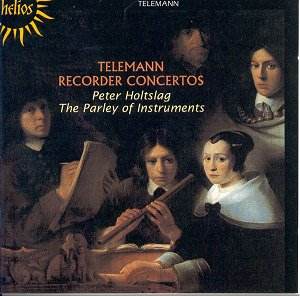 Composer: Georg Philipp Telemann (1681-1767)
Composer: Georg Philipp Telemann (1681-1767)
Works: Suite in A minor, Recorder Concerto in F major, Recorder Concerto in C major, Sinfonia in F major
Performers: Peter Holtslag, treble recorder; The Parley of Instruments, Peter Holman
Recording: Rec: December 1989
Label: HYPERION HELIOS CDH55091 [65.43]
Georg Philipp Telemann, one of the most prolific composers of the Baroque era, occupies a unique position in the history of the recorder, composing extensively for this instrument when it was both popular and on the brink of decline. His profound understanding of the recorder’s idiomatic capabilities is evident in the four works presented on this recording, which, while titled “Recorder Concertos,” includes a suite and a sinfonia alongside the concertos. This collection showcases Telemann’s versatility, blending the Italian concerto style with the French suite form, reflecting the cosmopolitan influences of his time.
The opening Suite in A minor serves as a substantial showcase for the recorder, extending over thirty minutes and occupying nearly half of the disc. Immediately, the listener is enveloped in the rich, textured sound of the Baroque recorder, which stands in marked contrast to the harsher tones of its Renaissance predecessor. The suite adheres to the traditional French dance forms, and Holtslag’s performance evokes the dramatic flair reminiscent of French opera overtures, imbued with the structural elegance characteristic of Bach’s orchestral suites. The Parley of Instruments under Holman’s direction navigates the intricate interplay between solo and ensemble with an agility that breathes life into the music, deftly avoiding the staid tempi that can plague less inspired interpretations.
In juxtaposition, the Recorder Concerto in F major, likely penned as early as 1708, reveals a simpler compositional approach, primarily alternating between solo and tutti passages. While effective, this work lacks the sophistication and depth found in the later Recorder Concerto in C major. The latter displays a more inventive structure, particularly in its first movement, where an intriguing pizzicato accompaniment for the solo recorder elevates the texture and complexity of the piece. Holtslag’s command of the instrument shines in this concerto, showcasing technical finesse and interpretative depth that draws the listener into the subtleties of Telemann’s writing.
The Sinfonia in F major, possibly derived from a church cantata, provides a refreshing contrast with its unique instrumental combination. Scored for recorder, solo bass viol, strings, cornett, three trombones, and organ, it harnesses a delightful blend of timbres. The recorder’s airy quality is beautifully complemented by the brass, creating an engaging dialogue that further emphasizes Telemann’s innovative orchestration techniques. The brief, three-movement work serves as an apt conclusion to the disc, leaving a lasting impression of the composer’s ability to create compelling music across varying forms and instrumentation.
This recording is not merely a showcase of Telemann’s output; it is a testament to the composer’s ability to transcend the limitations sometimes ascribed to his music. While some critics have dismissed his output as lacking character, this disc effectively counters that notion, presenting a composer capable of navigating a range of styles and emotions. The performance by Holtslag and The Parley of Instruments is exceptional, characterized by clarity, precision, and an infectious energy that enlivens every phrase. The sound quality, typical of Hyperion’s meticulous engineering, enhances the listening experience, allowing the nuances of the performance to resonate fully.
Telemann’s Recorder Concertos are not only delightful and engaging but also reveal the depth of his musical language. This recording stands as a significant contribution to the growing discography of Telemann’s works, offering both seasoned listeners and newcomers a rich tapestry of Baroque expression that is as enjoyable as it is enlightening.



